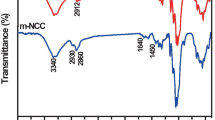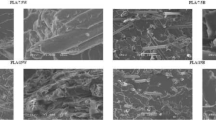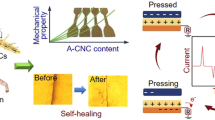Abstract
Biocomposites based on natural rubber (NR) reinforced with 45S5 Bioglass® (BG) particles were obtained by casting/evaporation method in which NR was dissolved in chloroform and mixed with BG particles. Structural, mechanical, and thermal tests were performed on the biocomposites to evaluate the influence of BG particles on the properties of the NR matrix. Thermogravimetric tests (TG/DTG) of the biocomposites showed decomposition profiles similar to that of NR, and the main peak of the DTG curve was well defined in the temperature range 300–450 °C, characteristic of the structural degradation of NR. The TG analysis also revealed that the thermal stability of the samples increases with the increasing quantity of BG in the biocomposite. DMA tests showed higher storage modulus (E′) values for samples with larger amounts of BG; however, above the T g, the E′ value tended to zero due to the increased mobility of the polymer chains. By analyzing tan δ, the T g values were calculated to be −46 and −50 °C for NR and the biocomposite samples, respectively. Mechanical testing demonstrated that the addition of BG to the biocomposite improved the mechanical properties of the samples. The samples became more rigid with the increasing quantity of BG, as demonstrated by decreasing deformation and the increasing elastic modulus (Y) and breaking strength of the samples. The BG particles positively affected the mechanical and thermal properties of the biocomposite, allowing its use in biomedical applications.






Similar content being viewed by others
References
Puppi D, Chiellini F, Piras AM, Chiellini E. Polymeric materials for bone and cartilage repair. Prog Polym Sci. 2010;35:403–40.
Ige OO, Umoru LE, Aribo S. Natural products: a minefield of biomaterials. ISRN Mater Sci. 2012;2012:1–20.
Sykaras N, Iacopino AM, Marker VA, Triplett RG, Woody RD. Implant materials, designs, and surface topographies: their effect on osseointegration. A literature review. Int J Oral Maxillofac Implants. 2000;15:675–90.
Boccaccini AR, Gough JE. Tissue engineering using ceramics and polymers. 2nd ed. New York: CRC Press; 2007.
Hench LL. The story of Bioglass®. J Mater Sci Mater Med. 2006;17:967–78.
Hench LL, Polak JM. Third-generation biomedical materials. Science. 2002;295:1014–7.
Reilly GC, Radin S, Chen AT, Ducheyne P. Differential alkaline phosphatase responses of rat and human bone marrow derived mesenchymal stem cells to 45S5 bioactive glass. Biomaterials. 2007;28:4091–7.
Hench LL, Wilson J. Introduction. In: Hench LL, Wilson J, editors. An introduction to bioceramics. Singapore: World Scientific Publishing Co. Pte. Ltd.; 1993. p. 1–24.
Jones JR. Review of bioactive glass: from Hench to hybrids. Acta Biomater. 2013;9:4457–86.
Gerhardt LC, Boccaccini AR. Bioactive glass and glass-ceramic scaffolds for bone tissue engineering. Materials. 2010;3:3867–910.
Bertolla L, Dlouhý I, Philippart A, Boccaccini AR. Mechanical reinforcement of Bioglass®-based scaffolds by novel polyvinyl-alcohol/microfibrillated cellulose composite coating. Mater Lett. 2014;118:204–7.
Eqtesadi S, Motealleh A, Perera FH, Pajares A, Miranda P. Poly-(lactic acid) infiltration of 45S5 Bioglass® robocast scaffolds: chemical interaction and its deleterious effect in mechanical enhancement. Mate Lett. 2016;163:196–200.
Oliveira AAR, Carvalho SM, Leite MF, Oréfice RL, Pereira MM. Development of biodegradable polyurethane and bioactive glass nanoparticles scaffolds for bone tissue engineering applications. J Biomed Mater Res A. 2012;100:1387–96.
Okamoto M, John B. Synthetic biopolymer nanocomposites for tissue engineering scaffolds. Prog Polym Sci. 2013;38:1487–503.
Mansur HS, Costa HS. Nanostructured poly(vinyl alcohol)/bioactive glass and poly(vinyl alcohol)/chitosan/bioactive glass hybrid scaffolds for biomedical applications. Chem Eng J. 2008;137:72–83.
Boccaccini AR, Maquet V. Bioresorbable and bioactive polymer/Bioglass® composites with tailored pore structure for tissue engineering applications. Compos Sci Technol. 2003;63:2417–29.
Kim IY, Sugino A, Kikuta K, Ohtsuki C. Bioactive composites consisting of PEEK and calcium silicate powders. J Biomater Appl. 2009;24:105–18.
Pon-On W, Charoenphandhu N, Teerapornpuntakit J, Thongbunchoo J, Krishnamra N, Tang I-M. Mechanical properties, biological activity and protein controlled release by poly(vinyl alcohol)–bioglass/chitosan–collagen composite scaffolds: a bone tissue engineering applications. Mater Sci Eng C. 2014;38:63–72.
Hild N, Tawakoli PN, Halter JG, Sauer B, Buchalla W, Stark WJ, Mohn D. pH-dependent antibacterial effects on oral microorganisms through pure PLGA implants and composites with nanosized bioactive glass. Acta Biomater. 2013;9:9118–25.
Stoppel WL, Ghezzi CE, McNamara SL, Black LD III, Kaplan DL. Clinical applications of naturally derived biopolymer-based scaffolds for regenerative medicine. Ann Biomed Eng. 2014;43:657–80.
Gomide VS, Zonari A, Ocarino NM, Goes AM, Serakides R, Pereira MM. In vitro and in vivo osteogenic potential of bioactive glass–PVA hybrid scaffolds colonized by mesenchymal stem cells. Biomed Mater. 2012;7:015004.
Eldesoqi K, Henrich D, El-Kady AM, Arbid MS, Abd El-Hady BM, Marzi I, Seebach C. Safety evaluation of a bioglass-polylactic acid composite scaffold seeded with progenitor cells in a rat skull critical-size bone defect. PLoS One. 2014;9:e87642.
Dong S, Sun J, Li Y, Li J, Cui W, Li B. Electrospun nanofibrous scaffolds of poly (L-lactic acid)-dicalcium silicate composite via ultrasonic-aging technique for bone regeneration. Mater Sci Eng C. 2014;35:426–33.
Rescignano N, Fortunati E, Montesano S, Emiliani C, Kennya JM, Martino S, Armentano I. PVA bio-nanocomposites: a new take-off using cellulose nanocrystals and PLGA nanoparticles. Carbohyd Polym. 2014;99:47–58.
Marelli B, Ghezzi CE, Barralet JE, Boccaccini AR, Nazhat SN. Three-dimensional mineralization of dense nanofibrillar collagen–bioglass hybrid scaffolds. Biomacromolecules. 2010;11:1470–9.
Liang SL, Cook WD, Thouas GA, Chen QZ. The mechanical characteristics and in vitro biocompatibility of poly(glycerol sebacate)-Bioglass® elastomeric composites. Biomaterials. 2010;31:8516–29.
Hajiali H, Hosseinalipour M, Karbasi S, Shokrgozar MA. The influence of bioglass® nanoparticles on the biodegradation and biocompatibility of poly(3-hydroxybutyrate) scaffolds. Int J Artif Organs. 2012;35:1015–24.
Chen Q, Garcia RP, Munoz J, Larraya UP, Garmendia N, Yao Q, Boccaccini AL. Cellulose nanocrystals-bioactive glass hybrid coating as bone substitutes by electrophoretic co-deposition; in situ control of mineralization of bioactive glass and enhancement of osteoblastic performance. ACS Appl Mater Interfaces. 2015;7:24715–25.
Li L, Zuo Y, Zou Q, Yang B, Lin L, Li J, Li Y. Hierarchical structure and mechanical improvement of an n-HA/GCO-PU composite scaffold for regeneration. ACS Appl Mater Interface. 2015;7:22618–29.
Cornish K. Similarities and differences in rubber biochemistry among plant species. Phytochemistry. 2001;57:1123–34.
Mark HF, Bikales NM, Oberberger CG, Menges G. Encyclopedia of polymer science and technology. 3rd ed. New York: Wiley; 2003.
Frade AA, Valverde RV, Assis RV, Coutinho-Netto J, Foss NT. Chronic phlebopathic cutaneous ulcer: a therapeutic proposal. Int J Dermatol. 2001;40:238–40.
Steinbüchel A. Production of rubber-like polymers by microorganisms. Curr Opin Microbiol. 2003;60:261–70.
Araujo MM, Massuda ET, Hyppolito MA. Anatomical and functional evaluation of tympanoplasty using a transitory natural latex biomembrane implant from the rubber tree Hevea brasiliensis. Acta Cirúrgica Brasileira. 2012;27:566–71.
Silva GA, Coutinho OP, Ducheyne P, Reis RL. Materials in particulate form for tissue engineering applications in bone. J Tissue Eng Regen Med. 2007;1:97–109.
Nascimento RM, Faita FL, Agostini DLS, Job AE, Guimarães FEG, Bechtold IH. Production and characterization of natural rubber–Ca/P blends for biomedical purposes. Mater Sci Eng C. 2014;39:29–34.
Borges FA, Bolognesi LFC, Trecco A, Drago BC, Arruda LB, Filho PNL, Pierri EG, Graeff CFO, Santos AG, Miranda MCR, Herculano RD. Natural rubber latex: study of a novel carrier for Casearia sylvestris Swartz delivery. ISRN Polym Sci. 2014;2014:1–5.
Bolognesi LFC, Borges LA, Cinman JLF, Silva RG, Santos AG, Herculano RD. Natural latex films as carrier for casearia sylvestris swartz extract associated with ciprofloxacin. Am Chem Sci J. 2015;5:17–25.
Barboza-Filho CG, Cabrera FC, Dos Santos RJ, De Saja Saez JA, Job AE. The influence of natural rubber/Au nanoparticle membranes on the physiology of Leishmania brasiliensis. Exp Parasitol. 2012;130:152–8.
Oliveira LCS, Arruda EJ, Costa RB, Gonçalves PS, Delben A. Evaluation of latex from five Hevea clones grown in São Paulo State, Brazil. Thermochim Acta. 2003;398:259–63.
Silva MJ, Sanches AO, Medeiros ES, Mattoso LHC, McMahan CM, Malmonge JA. Nanocomposites of natural rubber and polyaniline-modified cellulose nanofibrils. J Therm Anal Calorim. 2014;117:387–92.
Jawaid M, Abdul Khalil HPS, Alattas OS. Woven hybrid biocomposites: dynamic mechanical and thermal properties. Compos A. 2012;43:288–93.
Ornaghi HL, Bolner AS, Fiorio R, Zattera AJ, Amico SC. Mechanical and dynamic mechanical analysis of hybrid composites molded by resin transfer molding. J Appl Polym Sci. 2010;118:887–96.
Sanches AO, Ricco LHS, Malmonge LF, Silva MJ, Sakamoto WK, Malmonge JA. Influence of cellulose nanofibrils on soft and hard segments of polyurethane/cellulose nanocomposites and effect of humidity on their mechanical properties. Polym Test. 2014;40:99–105.
Manoharan S, Suresha B, Ramadoss G, Bharath B. Effect of short fiber reinforcement on mechanical properties of hybrid phenolic composites. J Mater. 2014;. doi:10.1155/2014/478549.
Jawaid M, Abdul Khalil HPS, Hassan A, Dungani R, Hadiyane A. Effect of jute fiber loading on tensile and dynamic mechanical properties of oil palm epoxy composites. Compos B. 2013;45:619–24.
Uma Devi L, Bhagawan SS, Thomas S. Dynamic mechanical analysis of pineapple leaf/glass hybrid fiber reinforced polyester composites. Polym Compos. 2010;31(6):956–65.
Siqueira G, Abdillahi H, Bras J, Dufresne A. High reinforcing capability cellulose nanocrystals extracted from Syngonanthus nitens (Capim Dourado). Cellulose. 2010;17:289–98.
Chan KW, Wong HM, Yeung KWK, Tjong SC. Polypropylene biocomposites with boron nitride and nanohydroxyapatite reinforcements. Materials. 2015;8:992–1008.
Author information
Authors and Affiliations
Corresponding author
Rights and permissions
About this article
Cite this article
Silva, M.J., Soares, V.O., Dias, G.C. et al. Study of thermal and mechanical properties of a biocomposite based on natural rubber and 45S5 Bioglass® particles. J Therm Anal Calorim 131, 735–742 (2018). https://doi.org/10.1007/s10973-016-5933-5
Received:
Accepted:
Published:
Issue Date:
DOI: https://doi.org/10.1007/s10973-016-5933-5




